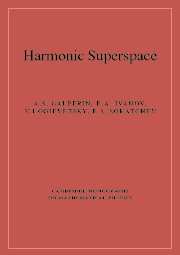Book contents
- Frontmatter
- Contents
- Preface
- 1 Introductory overview
- 2 Elements of supersymmetry
- 3 Superspace
- 4 Harmonic analysis
- 5 N = 2 matter with infinite sets of auxiliary fields
- 6 N = 2 matter multiplets with a finite number of auxiliary fields. N = 2 duality transformations
- 7 Supersymmetric Yang–Mills theories
- 8 Harmonic supergraphs
- 9 Conformal invariance in N = 2 harmonic superspace
- 10 Supergravity
- 11 Hyper-Kähler geometry in harmonic space
- 12 N = 3 supersymmetric Yang–Mills theory
- 13 Conclusions
- Appendix: Notations, conventions and useful formulas
- References
- Index
11 - Hyper-Kähler geometry in harmonic space
Published online by Cambridge University Press: 24 August 2009
- Frontmatter
- Contents
- Preface
- 1 Introductory overview
- 2 Elements of supersymmetry
- 3 Superspace
- 4 Harmonic analysis
- 5 N = 2 matter with infinite sets of auxiliary fields
- 6 N = 2 matter multiplets with a finite number of auxiliary fields. N = 2 duality transformations
- 7 Supersymmetric Yang–Mills theories
- 8 Harmonic supergraphs
- 9 Conformal invariance in N = 2 harmonic superspace
- 10 Supergravity
- 11 Hyper-Kähler geometry in harmonic space
- 12 N = 3 supersymmetric Yang–Mills theory
- 13 Conclusions
- Appendix: Notations, conventions and useful formulas
- References
- Index
Summary
The aim of this chapter is to show that the concept of harmonic analyticity has deep implications not only in N = 2 (and N > 2) supersymmetry, but also in purely bosonic (N = 0) gauge theories. Namely, this concept allows one to obtain unconstrained geometric formulations of self-dual Yang–Mills theory and hyper-Kähler geometry. These formulations closely parallel those of N = 2 Yang–Mills theory and N = 2 supergravity in harmonic superspace. The basic objects are unconstrained potentials defined on an analytic subspace of the harmonic extension of the original space (in the general case it is ℝ4n × S2). They encode all the information about the quantities present in the conventional formulations, self-dual Yang–Mills connections in the first case and hyper-Kähler metrics in the second one. We show that the harmonic analytic potential of the most general hyper-Kähler manifold serves as the Lagrangian of the most general N = 2 sigma model (after identifying the coordinates of the analytic subspace of this manifold with the analytic superfields q+ describing N = 2 matter). This establishes a direct, one-to-one correspondence between N = 2 sigma models and hyper-Kähler manifolds.
Introduction
In the previous chapters we demonstrated the relevance of the harmonic variables for obtaining an adequate formulation of N = 2 supersymmetric theories.
- Type
- Chapter
- Information
- Harmonic Superspace , pp. 217 - 262Publisher: Cambridge University PressPrint publication year: 2001



